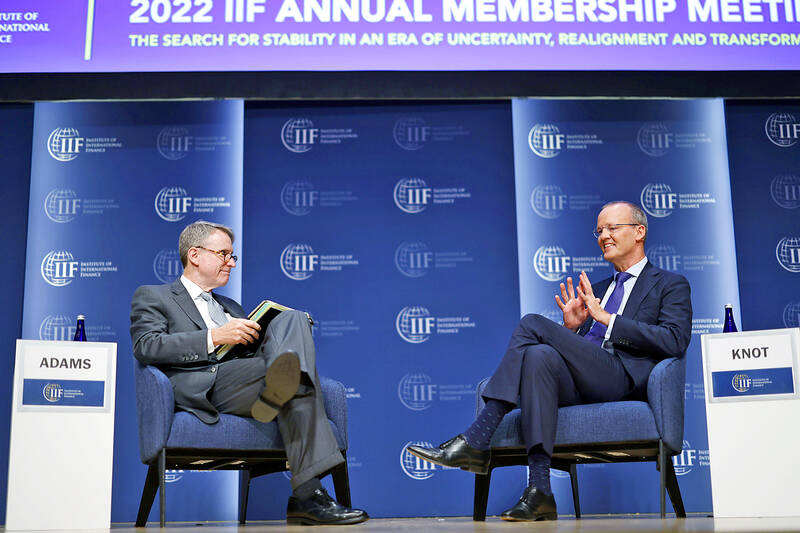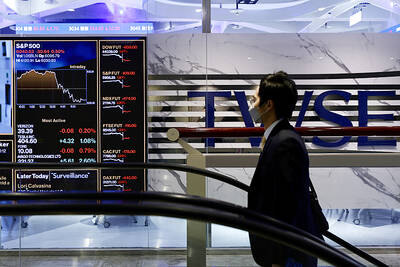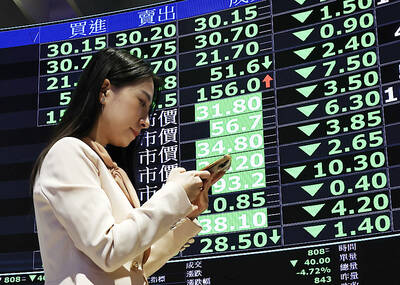Hawkish European Central Bank (ECB) officials aim to start unwinding the institution’s 5.1 trillion euro (US$4.98 trillion) asset hoard by early yesterday while retaining interest rates as their primary monetary-policy tool, people familiar with the matter said.
A consensus is emerging among some Governing Council members that the process of shrinking the balance should run in the background while the ECB focuses on setting borrowing costs, they said, declining to be identified because discussions on the matter are private.
That would require a decision on a framework that could then be revisited after a period of time, the people said.

Photo: Bloomberg
The officials favor letting bonds mature rather than resorting to debt sales, though that option should not be entirely excluded. They could also envisage keeping up some reinvestments to moderate the pace of unwinding.
An ECB spokesperson declined to comment on plans to unwind the balance sheet.
ECB hawks have effectively dictated the momentum of monetary policy since early June, a dominance over decisionmaking that suggests their opinions might well continue to hold sway.
Officials started discussions on a possible strategy for so-called quantitative tightening (QT) last week at a meeting in Cyprus, Central Bank of Luxembourg Governor Gaston Reinesch said in a blog post on Wednesday.
How to begin offloading bonds bought up over several years of stimulus is a highly sensitive matter for the ECB.
Its monetary policy has struggled to stay focused against the distraction of how more restrictive measures might hurt Italy’s debt sustainability.
A blowout in that country’s bond yields in June forced officials to devise a new crisis tool to ensure that they could continue raising interest rates without harming the integrity of the euro region.
The Bank of England’s own confrontation with financial-market turmoil in recent weeks similarly illustrates the dangers of how a plan to reduce bond holdings can go awry.
Dutch central bank President Klaas Knot told Bloomberg Television on Wednesday about how the ECB would want to do things differently from the British central bank.
“They actively have to sell” because of their long-dated portfolio, he said.
“Like in the US, we have bonds over the full maturity, and we think we can do QT by just rolling off existing bonds by less than full reinvestment, which is naturally a smoother process,” he said.
ECB officials are agreed that they should not start shrinking the balance sheet until they reach a level of rates deemed to be neutral — neither stimulating nor constricting the economy.
It is likely that they might do that as soon as December.
“The question arises obviously as to how this which has now been stopped in terms of net asset purchases should be reversed: with which horizon, at which pace,” ECB President Christine Lagarde said on Wednesday. “This is a discussion which we have started and that will be continued.”
The opportune time to begin winding the balance sheet down would be March next year, said David Powell at Bloomberg Economics, who predicts an average reduction of 29 billion euros a month, or just under 1 percent of the size of the combined portfolios of quantitative easing and pandemic emergency bond purchases.
“At that pace, nine to 10 years would be required to offload all of the securities held,” he wrote in a report published yesterday. “The ECB may implement active bond sales to hasten the shrinkage of the balance sheet. That will depend on market conditions and the inflation outlook — we expect the Governing Council to tread cautiously.”

SELL-OFF: Investors expect tariff-driven volatility as the local boarse reopens today, while analysts say government support and solid fundamentals would steady sentiment Local investors are bracing for a sharp market downturn today as the nation’s financial markets resume trading following a two-day closure for national holidays before the weekend, with sentiment rattled by US President Donald Trump’s sweeping tariff announcement. Trump’s unveiling of new “reciprocal tariffs” on Wednesday triggered a sell-off in global markets, with the FTSE Taiwan Index Futures — a benchmark for Taiwanese equities traded in Singapore — tumbling 9.2 percent over the past two sessions. Meanwhile, the American depositary receipts (ADRs) of Taiwan Semiconductor Manufacturing Co (TSMC, 台積電), the most heavily weighted stock on the TAIEX, plunged 13.8 percent in

A wave of stop-loss selling and panic selling hit Taiwan's stock market at its opening today, with the weighted index plunging 2,086 points — a drop of more than 9.7 percent — marking the largest intraday point and percentage loss on record. The index bottomed out at 19,212.02, while futures were locked limit-down, with more than 1,000 stocks hitting their daily drop limit. Three heavyweight stocks — Taiwan Semiconductor Manufacturing Co (TSMC, 台積電), Hon Hai Precision Industry Co (Foxconn, 鴻海精密) and MediaTek (聯發科) — hit their limit-down prices as soon as the market opened, falling to NT$848 (US$25.54), NT$138.5 and NT$1,295 respectively. TSMC's

TARIFFS: The global ‘panic atmosphere remains strong,’ and foreign investors have continued to sell their holdings since the start of the year, the Ministry of Finance said The government yesterday authorized the activation of its NT$500 billion (US$15.15 billion) National Stabilization Fund (NSF) to prop up the local stock market after two days of sharp falls in reaction to US President Donald Trump’s new import tariffs. The Ministry of Finance said in a statement after the market close that the steering committee of the fund had been given the go-ahead to intervene in the market to bolster Taiwanese shares in a time of crisis. The fund has been authorized to use its assets “to carry out market stabilization tasks as appropriate to maintain the stability of Taiwan’s

STEEP DECLINE: Yesterday’s drop was the third-steepest in its history, the steepest being Monday’s drop in the wake of the tariff announcement on Wednesday last week Taiwanese stocks continued their heavy sell-off yesterday, as concerns over US tariffs and unwinding of leveraged bets weighed on the market. The benchmark TAIEX plunged 1,068.19 points, or 5.79 percent, to 17,391.76, notching the biggest drop among Asian peers as it hit a 15-month low. The decline came even after the government on late Tuesday authorized the NT$500 billion (US$15.2 billion) National Stabilization Fund (國安基金) to step in to buoy the market amid investors’ worries over tariffs imposed by US President Donald Trump. Yesterday’s decline was the third-steepest in its history, trailing only the declines of 2,065.87 points on Monday and